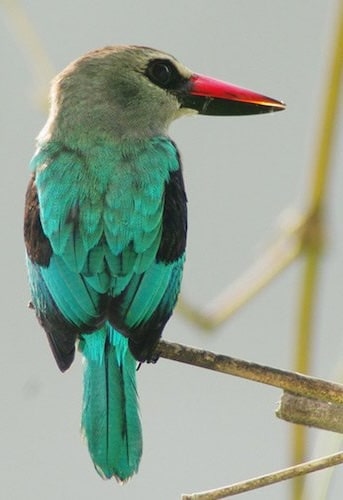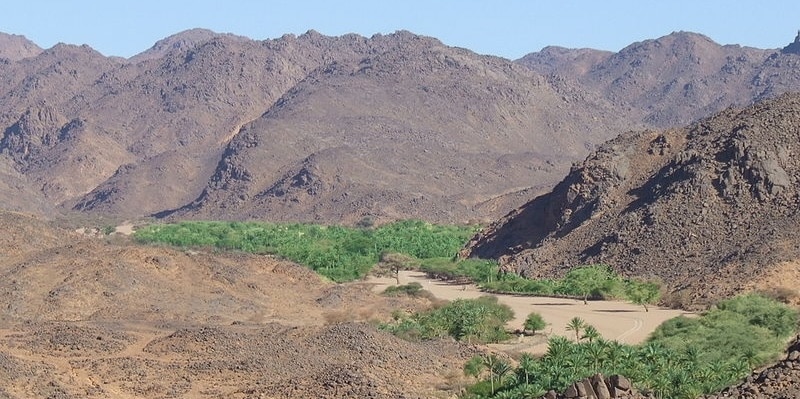Republic of the Niger

Niger is a landlocked country in West Africa. It is a unitary state bordered by Libya to the northeast, Chad to the east, Nigeria to the south, Benin and Burkina Faso to the southwest, Mali to the west, and Algeria to the northwest. It covers a land area of almost 1,270,000 km2 (490,000 square miles), making it the largest landlocked country in West Africa and the second largest landlocked nation in Africa behind Chad. Over 80% of its land area lies in the Sahara. Its predominantly Muslim population of about 28 million lives mostly in clusters in the south and west of the country. The capital Niamey, with a population of about 1.5 million people, is located in Niger’s southwest corner along the namesake Niger River.
Niger also has a rich past as the geology and the famous dinosaur fossils demonstrate. Human presence in Niger goes back approximately 60,000 years. Rock carvings in the Aïr and Djado, in the deserts of the north of the country, testify to the former presence there of elephants and hippos at a time when the Sahara was lush and green. The economy is concentrated around subsistence and some export agriculture clustered in the more fertile south, and the export of raw materials such as uranium ore. Niger remains handicapped by its landlocked position, poor education, infrastructure, health care, and environmental degradation.
The lowest point in Niger is the Niger River, with an elevation of 656 feet. The highest point is Mont Idoukal-n-Taghès in the Aïr Mountains at 6,634 feet. Niger’s terrain is predominantly desert plains and sand dunes, with flat to rolling savanna in the south and hills in the north.

Timia Valley, Aïr Mountains – ©Denvermaxwell at English Wikipedia, Public domain, via Wikimedia Commons
There is a hot and dry climate within the desert areas, whereas, In the south, there is a tropical climate on the edges of the Niger River basin.
Niger contains five terrestrial ecoregions: Sahelian Acacia savanna, West Sudanian savanna, Lake Chad flooded savanna, South Saharan steppe and woodlands, and West Saharan montane xeric woodlands.
The north is covered by deserts and semi-deserts. The typical mammal fauna consists of addax antelopes, scimitar-horned oryx, gazelles, and in the mountains, Barbary sheep. The Aïr and Ténéré National Nature Reserve was founded in the northern parts to protect these species.
The southern parts are naturally dominated savannahs. The W National Park, situated in the bordering area to Burkina Faso and Benin, belongs to “one of the most important areas” for wildlife in Western Africa, which is called the WAP (W-Arli-Pendjari) Complex. It has a population of the West African lion and one of the last populations of the Northwest African cheetah. Other wildlife includes elephants, buffaloes, roan antelopes, kob antelopes and warthogs. The West African giraffe is found in the further north where it has its last relict population.
Birding Niger
Most of the very friendly Nigeriens are Sunni Muslim. There are some seven major ethnic groups. French, however, is the most widely spoken language, and it adds a lot to your visit to Niger if you know at least a few words. Although lacking in tourist infrastructure outside Niamey, Parc du W and the Aïr, there certainly is suitable accommodation in Niger for birders on tight budgets.

Dunes near Niamey – ©Vincent van Zeijst CC BY-SA 4.0 via Wikimedia Commons
Bird-wise much remains to be discovered in Niger. Only the area around the capital Niamey, Makalondi district and Parc National du W, all in the southwest of the country, and the Aïr Mountains in the north, have been birded more or less systematically. Even in those areas new species for the country are still found regularly. The country list stands at approximately 545 species at present. These include colourful Afrotropical residents, enigmatic Afrotropical migrants, and familiar Palearctic migrants in surroundings that make you appreciate them anew. Niger has no endemic or restricted-range species, but it is an excellent country to see Sahara-Sindian, Sahelian and Sudan-Guinea Savanna biome species. The nature of the terrain and the vegetation are such that you actually get to see most birds, rather than only hear them. In many places you can also go off the beaten track quite easily. Only in the extreme southwest, in and around Parc National du W, do you need to watch out for large predators.
Banding and satellite-tracking studies have shown that Niger shares at least some of its birds with 80 other countries, from Guinea to the Shetland Islands, across Scandinavia to Russia and Kazakhstan, and via the Caucasus, Middle East and East Africa down to Madagascar, South Africa and Namibia. For a further 7 countries, links are probable based on likely migration routes between banding and recovery locations. Further countries will no doubt be added as new information becomes available. With all these comings and goings, the composition of the avifauna of Niger truly changes all the time, throughout the year.

Mekrou River in W National Park – ©Marco Schmidt CC BY-SA 3.0 via Wikimedia Commons
While in the country you will not want to miss the giraffes 70 km south-east of Niamey nor perhaps the hippos at Ayorou on the Niger River, near the border with Mali. When birding in Parc du W, you will obviously also enjoy looking for the considerable variety of antelope, monkeys, buffalo, elephants, and with a lot of luck even a lion, leopard or cheetah. In relaxed Niamey itself a visit to the National Museum is a must, with its various ethnological and natural history collections, and its artisans at work in an open shed. After a hard day birdwatching or sightseeing, don’t forget to relax with a drink on the terrace of the Grand Hotel overlooking the Niger River watching the camels, pedestrians, motorbikes and cars cross the bridge, and the local longboats plying their trade. As the sun goes down you will see the flying foxes spreading out from their dormitories, pitch black in the fading light. You will be glad you came to Niger.
-
Number of bird species: 545
(As at February 2025)
-
Avibase
PDF ChecklistThis checklist includes all bird species found in Niger , based on the best information available at this time. It is based on a wide variety of sources that I collated over many years. I am pleased to offer these checklists as a service to birdwatchers. If you find any error, please do not hesitate to report them. -
E-Bird
PDF ChecklistThis checklist is generated with data from eBird (ebird.org), a global database of bird sightings from birders like you. If you enjoy this checklist, please consider contributing your sightings to eBird. It is 100% free to take part, and your observations will help support birders, researchers, and conservationists worldwide. -
Wikipedia
Annotated ListThis is a list of the bird species recorded in Niger. The avifauna of Niger include a total of 542 species, of which one has been introduced by humans. 18 species are globally threatened.
-
Birds of Western Africa
| By Nik Borrow & Ron Demey | Christopher Helm | 2014 | Paperback | 592 pages, 266 plates with colour illustrations; colour distribution maps | ISBN: 9781472905680 Buy this book from NHBS.com -
Birds of Western and Central Africa
| By Ber van Perlo | Princeton University Press | 2003 Paperback | 384 pages, 109 plates with colour illustrations; colour & b/w illustrations, 1500+ b/w distribution maps, colour maps | Out of Print | ISBN: 9780691007144 Buy this book from NHBS.com

Birds of Africa
Apple iOS | AndroidBirds of Africa is an identification guide which in time will cover all the birds and countries in Africa. This version includes more than 1,800 species and has all West African and 8 East African countries.Organisations-
African Bird Club
WebsiteBird-wise much remains to be discovered in Niger. Only the area around the capital Niamey, Makalondi district and Parc National du W, all in the south-west of the country, and the A -
West African Ornithological Society
WebsiteThe West African Ornithological Society grew out of the Nigerian Ornithologists
Reserves-
*List of national parks of Niger
InformationSatellite ViewNiger is home to a number of national parks and protected areas, including two UNESCO-MAB Biosphere Reserves. With interactive list... -
Gadabedji Reserve
InformationSatellite ViewThe Gadabedji Total Reserve (Réserve totale de Faune du Gadabedji) is a nature reserve in the central region of Niger. It is a Total Faunal Reserve IUCN type IV, covering some 76,000 hectares within the northern tip of the Maradi Region, just north of the town of Dakoro, and south of the border with the Agadez Region. The reserve is also recognized biosphere reserve by the Unesco since 2017 -
IBAs
WebsiteSatellite ViewInformation -
NNR Aïr and Ténéré
InformationSatellite ViewIt covers both the eastern half of the Aïr Mountains and the western sections of the Ténéré desert. It has been identified by BirdLife International as an Important Bird Area. The entire reserve covers 77,360 square kilometres (29,870 sq mi), which made it the second largest nature reserve in Africa, and the fourth largest in the world. -
NP W National Park
InformationSatellite ViewA major national park in West Africa around a meander in the River Niger shaped like the letter W. The park includes areas of the three countries Niger, Benin and Burkina Faso, and is governed by the three governments. -
NR Tadres
InformationSatellite ViewThe Tadrès Total Reserve (T'adéras/Tadress) (Réserve totale de Faune du Tadrès) is a nature reserve in the central north of Niger, southwest the city of Agadez. -
RAMSAR Kokorou wetland
InformationSatellite ViewThe large, shallow and brackish Kokoro wetland lies in an ancient valley surrounded by sand-dunes, granite outcrops and flat-topped hills. Covering 668 km2, the wetland hosts migratory birdlife and is important to the local ecology.
Sightings, News & Forums-
eBird
SightingseBirding This Month
-
Fatbirder - linking birders worldwide...
Skip to content
